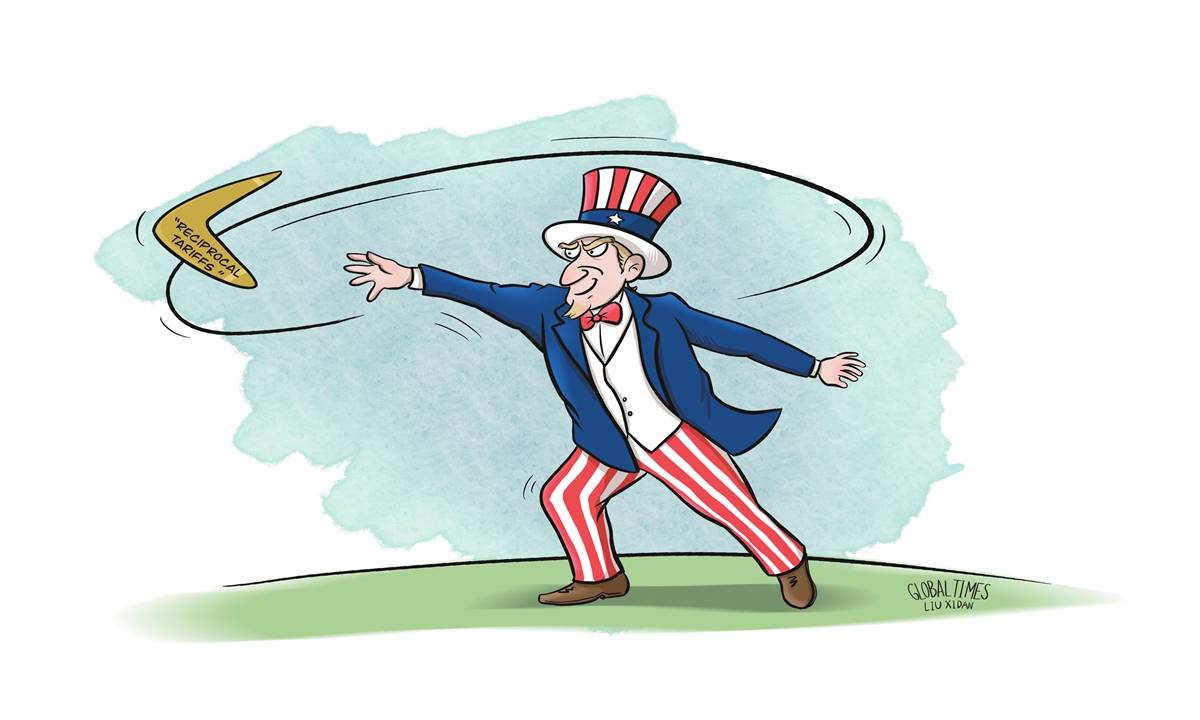
Illustration: Liu Xidan/GT
Amid the intense "reciprocal tariff" war waged by the US, it is increasingly obvious that Washington's extreme "reciprocal tariff" policies are far away from reaching their goals. According to a report by Bloomberg, the US Customs and Border Protection on Friday evening local time issued a statement announcing exemptions for several products, including some consumer electronics and memory chips. Experts have noted that manufacturing these products in the US is not feasible in the short term, and the exemption list demonstrates that the White House has finally recognized "the reality of the situation."Just several days ago, the US government unexpectedly announced a 90-day hold on "reciprocal tariffs" toward most countries, but raised tariffs on China to 145 percent. While varying tariff rates for other countries are still just numbers, global trade and financial markets have already felt the impact. The US initiation of the tariff war against the world is not merely about using tariffs as leverage to coerce other countries; it reflects the core governing philosophy and policy priorities of the current US government.
The US has repeatedly claimed its tariff push has two goals. The first is to boost revenue and reduce the federal deficit - which hit $1.3 trillion in the first half of fiscal year 2025, the second-largest six-month deficit on record, according to Treasury data.
The second goal is to attract investment and reshore manufacturing. Maintaining the dollar's global dominance and developing domestic manufacturing present an inherent contradiction. The US trade deficit is structural. Only when the US maintains a trade deficit can newly issued dollars circulate globally and be available to other countries.
After obtaining dollars, these countries recycle them by purchasing US Treasury bonds, depositing them in US banks, and investing in Wall Street financial products. This forms a closed loop, and it is within this loop that the dollar maintains its dominant position in the global monetary system. So, if the Trump administration no longer exports dollars to other countries through trade deficits, would this mean that the US would have to voluntarily relinquish the hegemonic status of its dollar?
Can the US tariff war really revitalize manufacturing? As a universal rule, developing manufacturing requires a skilled talent pool, robust infrastructure (such as electricity, transportation, and logistics), industrial support, and various policy incentives to form an integrated capability that improves efficiency and reduces manufacturing costs.
For years, as a financial powerhouse, the US has seen a large number of STEM (science, technology, engineering and mathematics) graduates from its universities enter the high-paying financial sector. Compared to the financial industry, manufacturing is capital-intensive and offers lower returns, leading to a severe shortage of the talent needed for manufacturing.
Additionally, the infrastructure required for US manufacturing faces numerous issues that cannot be resolved in the short term. Thus, the US administration's attempt to reduce imports through high tariffs and force domestic production to revitalize manufacturing cannot be fundamentally solved by bringing manufacturing back only.
On one hand, the US is reluctant to give up the various hegemonic benefits enjoyed by the dollar; on the other hand, it hopes to reduce imports through tariffs and force companies to produce domestically to revive manufacturing. However, these objectives are fundamentally at odds, highlighting a significant gap between goals and reality.
Since the advent of industrial society, international trade has been characterized by interdependence. Market advantage depends on manufacturing strength, not on who has higher tariff barriers or adopts protectionist policies.
The US attempt to use tariff barriers to rejuvenate its manufacturing sector is bound to fail. And the unilateral attempt to change the global trade system will inevitably trigger widespread countermeasures from the majority of countries worldwide, accelerating China's efforts with other nations to build a more "de-Americanized" international trade landscape.
The implementation of the US "reciprocal tariff" plan has shattered any remaining illusions. The non-economic rationality of the Trump administration has set historical records. Although a few countries may agree to reach agreements with the US, but, even with threats and coercion, the US cannot possibly coerce every country in the world into compliance.
China's firm measures have clearly stated its stance: Talk? Our door is wide open. Fight? We will fight to the end!
The author is deputy secretary general of the Belt and Road Center at the Chinese Academy of Social Sciences. opinion@globaltimes.com.cn


